I Made a Shooter’s Sandwich
I’m trying to pinpoint when I first heard about the near-mythical Shooter’s Sandwich. It was years ago, decades… perhaps it was the 1996 episode of Two Fat Ladies, in which the late Jennifer Paterson made a shooter’s sandwich of rump roast and mushrooms in a regular rectangular loaf of white bread for a boy scout outing. It could have been one of the many times since then that a shooter’s sandwich variant of one kind or another has “gone viral” on the internet. I made an ill-advised attempt at a muffaletta variant of the shooter’s sandwich myself a while back and I know that these don’t always turn out as delicious as they look.
So now that it’s time for the Tribunal to tackle the shooter’s sandwich, what is there to do but make the most traditional one I can, within reason? I say within reason because, for example, the traditional bread shape for these was apparently the rectangular loaf, but you see most of them being made in a round loaf these days, which is more symmetrical and just makes more sense–they are called boules, or “bowls,” for a reason.
So what is a traditional shooter’s sandwich? At its essence, it is a portable, sandwichized, and perhaps somewhat lowbrow version of Beef Wellington, seared beef tenderloin packed with mushroom duxelles into a hollowed out bread loaf, dressed like a beef sandwich with hot English mustard and horseradish, pressed overnight, and then carried into the field to be eaten whilst shooting game birds. I say lowbrow, but this is still the realm of the gentry–on an English game shoot, the lower classes were hired as beaters, to move through the brush and startle birds into flight, whereupon they were shot by a group of upper-crust nobs who were otherwise milling around, drinking brandy, and eating slices of these giant sandwiches.
I’m not going to shoot anything (other than a bunch of photographs), and by the time I’m done I’ll have probably 3/4 of a 10″ boule-sized sandwich left over. I’m game for this sandwich though. I’ve been looking forward to it.
First, we’ll need a boule. I could go pick one up at just about any bakery but I thought I’d give it a shot myself. I don’t have a good sourdough starter right now, but I used a poolish pre-ferment, which gives a sizable proportion of the dough a longer fermentation, adding flavor and stability to the dough. The dough was about 15% whole wheat flour and 85% bread flour with 70% hydration, and was proofed in a round banneton, giving it a more rustic appearance. It baked in a preheated Dutch oven for just shy of an hour.
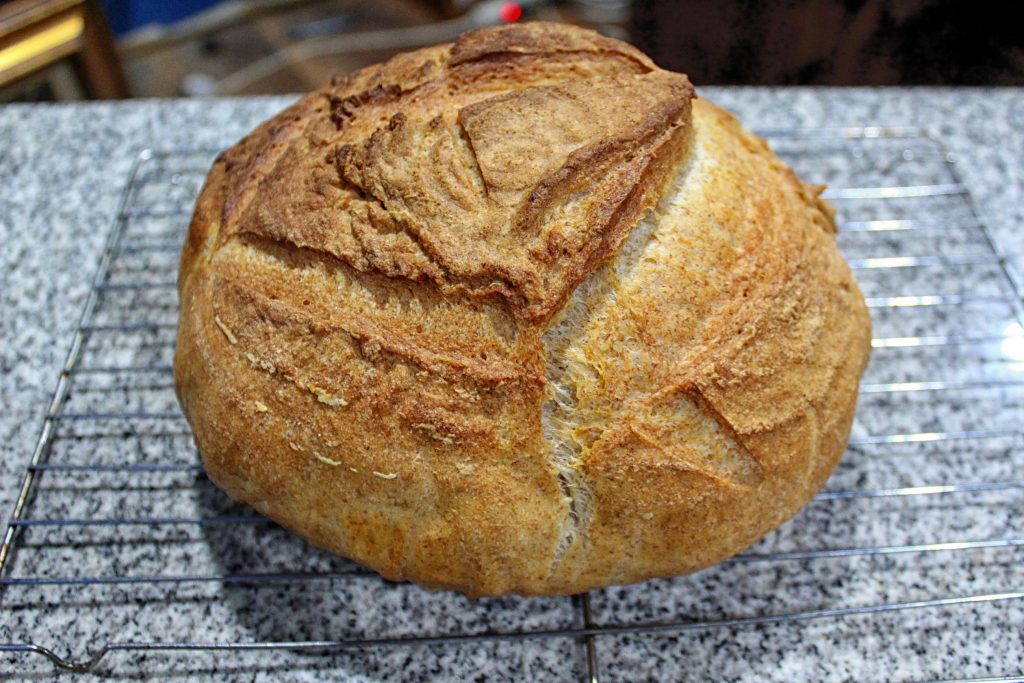
The next thing to prepare ahead of time is the mushroom duxelles. This is a finely chopped mixture of mushrooms and shallots, sauteed in butter until all the moisture from the mushrooms is extracted and reduced, at which point herbs and white wine are added and cooked until the wine is again reduced to leave a soft spreadable paste.
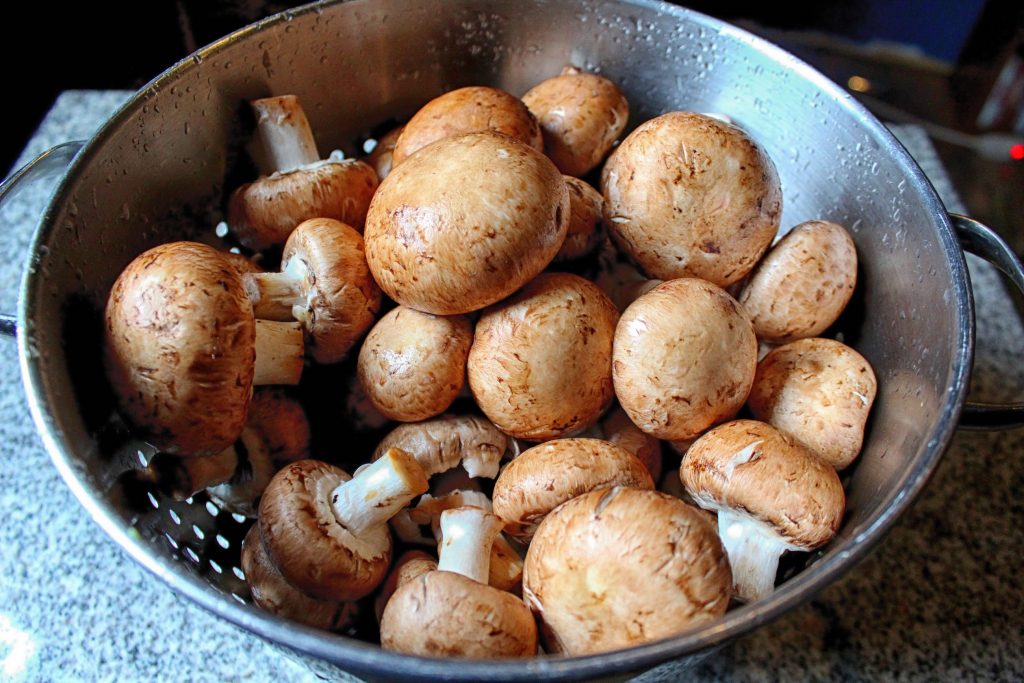
I used 2 lbs of cremini mushrooms along with a half pound of white button mushrooms and another half pound of shiitakes, 3/4 cup of butter, half a cup of dry white wine, finely chopped parsley and thyme, seasoned with sea salt and black pepper.
Now take a look at those mushrooms above. Read the description of the ingredients and method again. Look, a mushroom duxelles isn’t exactly pretty, OK? I’m going to show you a picture now.
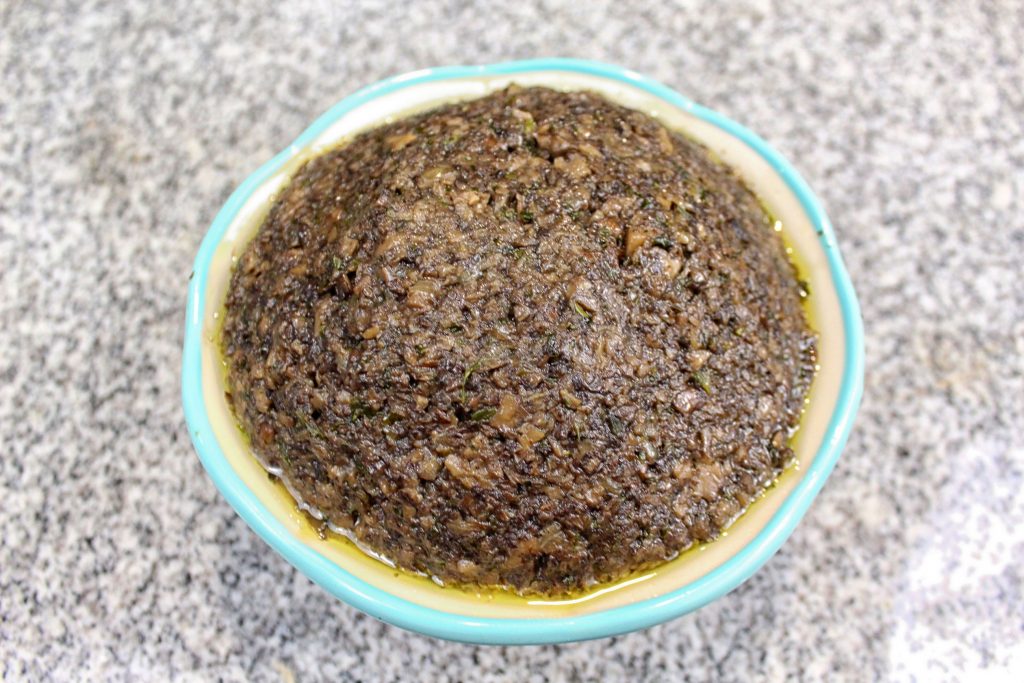
It’s a pile of brown muck, I know. I get it. But it’s a delicious pile of brown muck. It’s a pile of brown muck that I could seriously sit down and eat by the spoonful until it’s all gone. You would too. You may not even like mushrooms. You may be deathly allergic to mushrooms. You would literally eat this gross-looking pile of brown muck by the spoonful until your throat closed up and you were rushed to the hospital by well-meaning folks who don’t realize, who just don’t understand that it was all worth it.
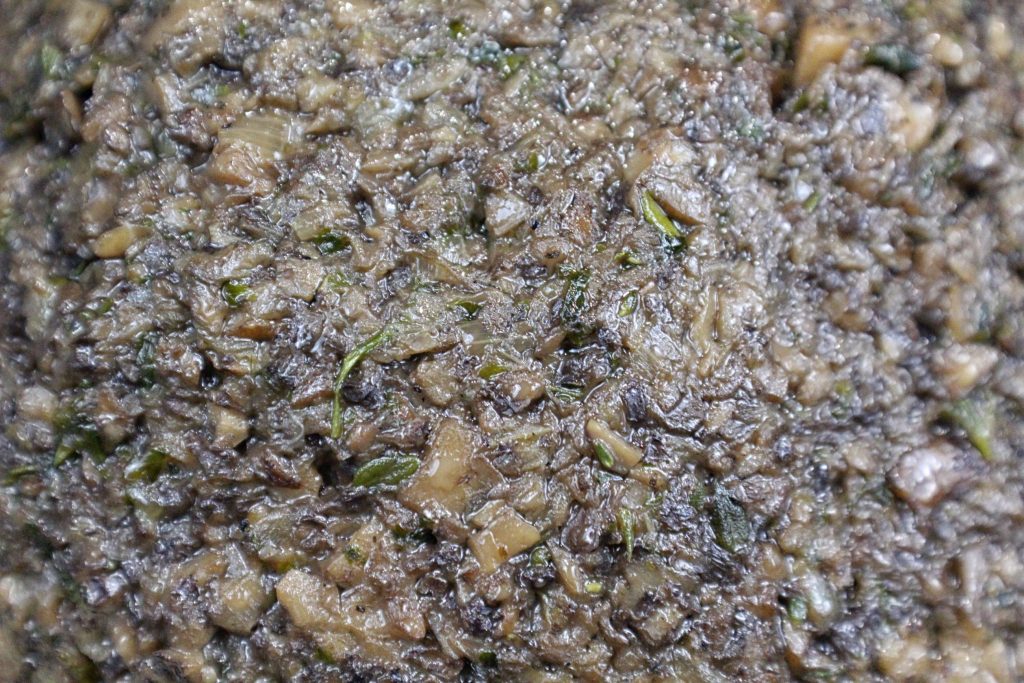
Finally, there’s the meat. I’m using a full beef tenderloin. I had big dreams for that tenderloin, dreams of expertly butterflying it to a consistent thickness, just big enough for 2 layers of meat to fill my boule. Instead, I butchered it. That is, I butchered the butchering of it. Nobody needs to see the evidence of my gross ineptitude in this and I ask you to respect my family’s privacy at this time.
Instead, I seasoned and pan-fried the filets I was able to rescue from my poor mangled tenderloin, and I seasoned and pan-fried the smaller bits from the tenderloin ends, and some of the mangled pieces as well, to something like rare, about 2 1/2 minutes per side in a very hot cast-iron pan.
Building the Shooter’s Sandwich
We start with the boule, slicing the “lid” off the top with a good bread knife.
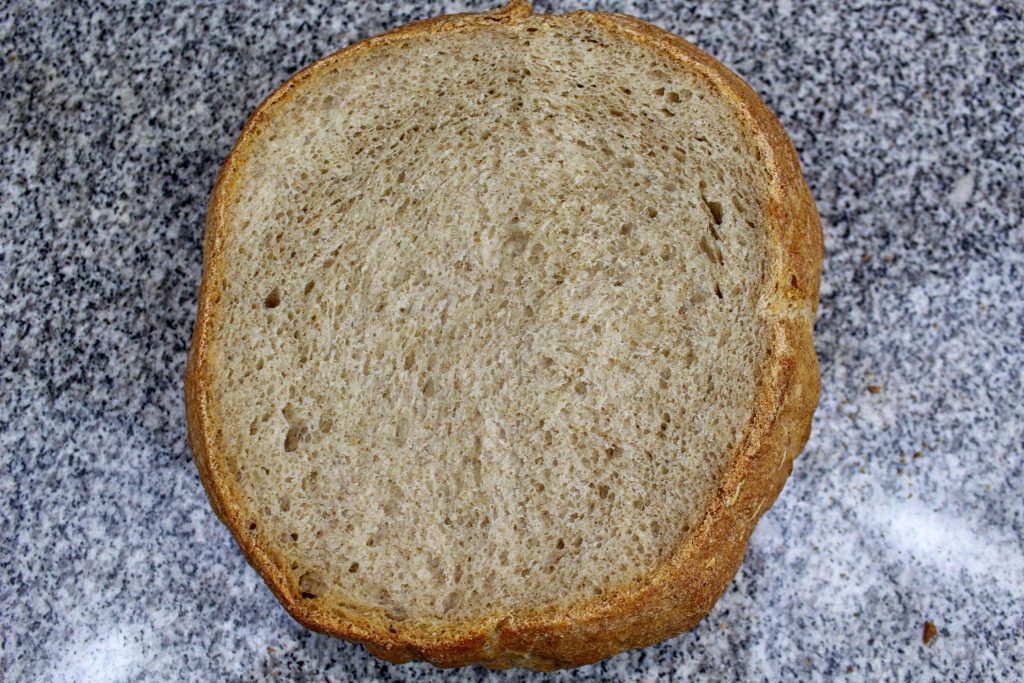
Then, using knife, fork, fingers, whatever works, we remove the crumb from inside the boule, and inside the lid, leaving 1/2″ to 3/4″ all around.
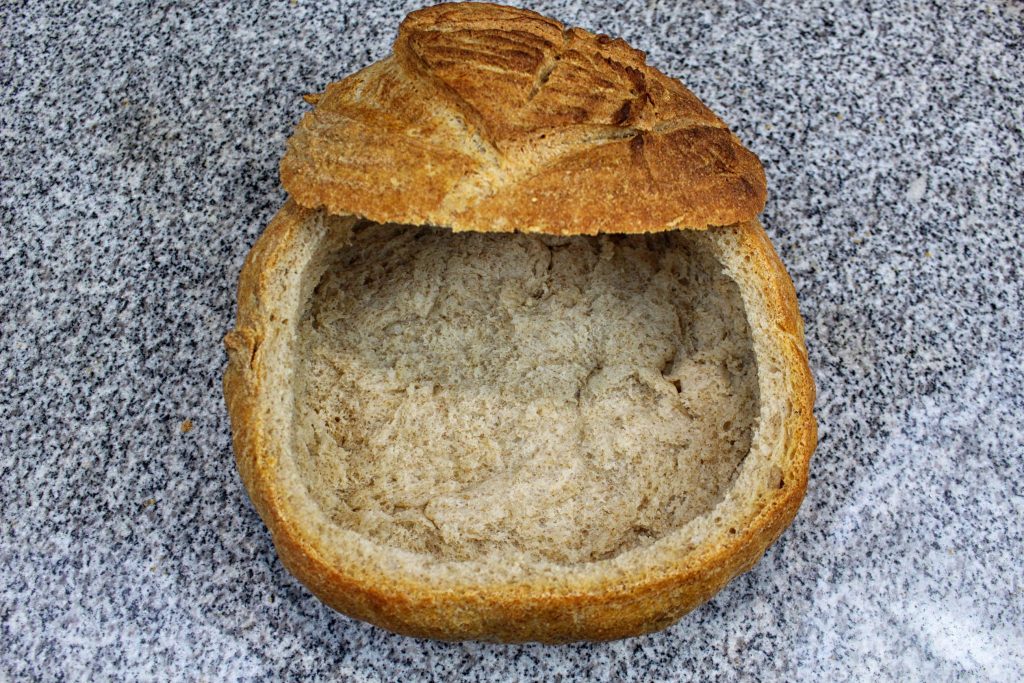
Before adding the ingredients, I’m spreading a good layer of Colman’s English Mustard all around the bottom of the boule.
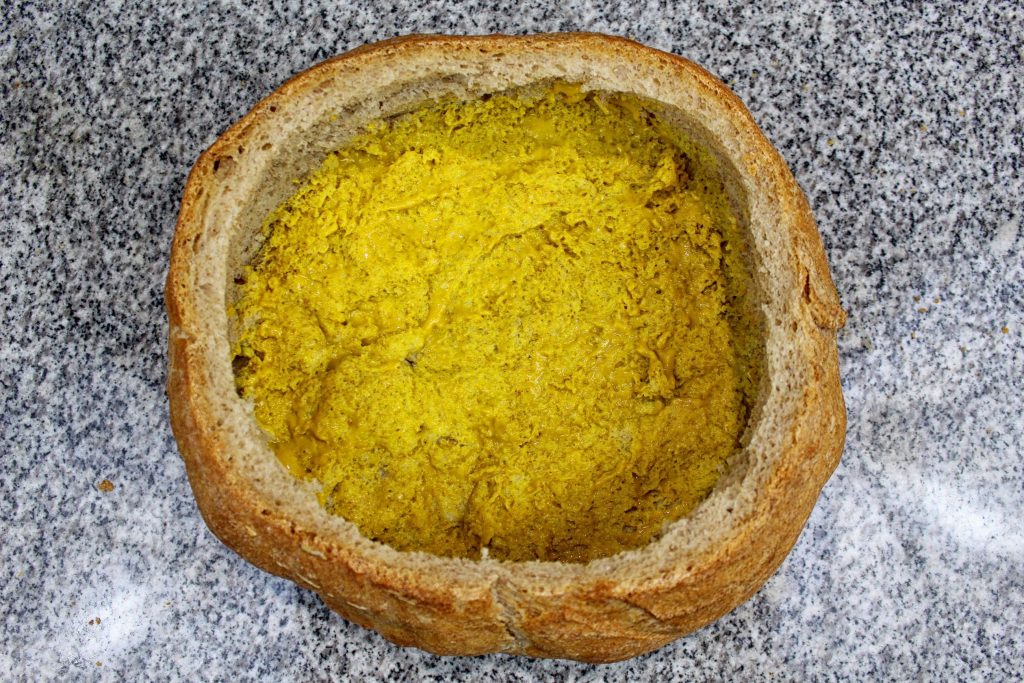
I added a layer of hot prepared horseradish on top of the mustard before a layer of the seared tenderloin about an inch thick.
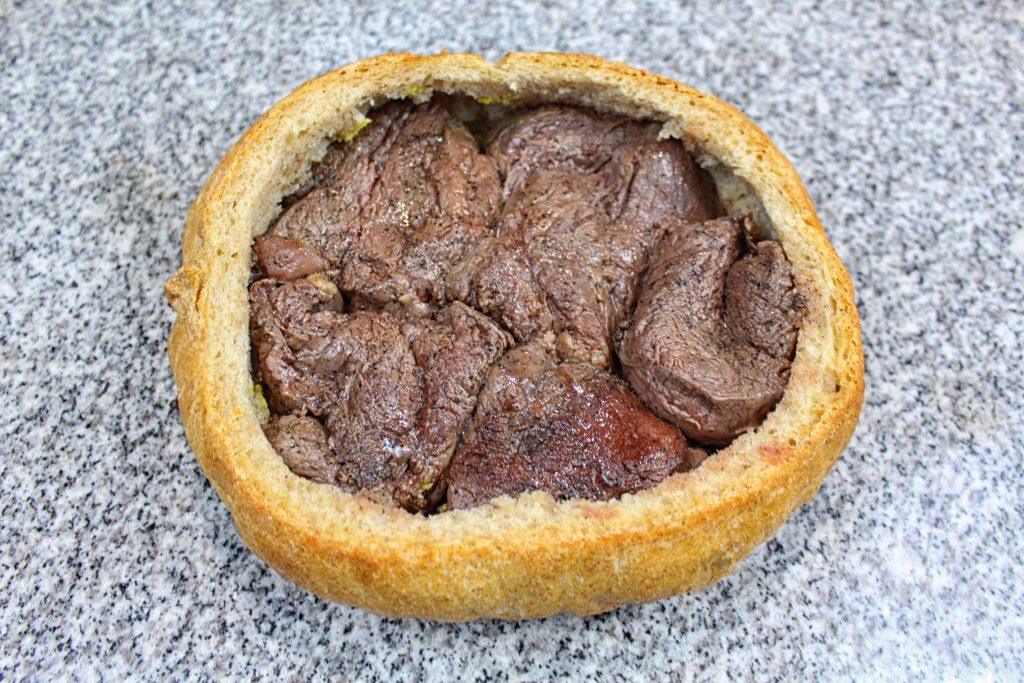
On top of the tenderloin, I spread about an inch thick layer of the mushroom duxelles.
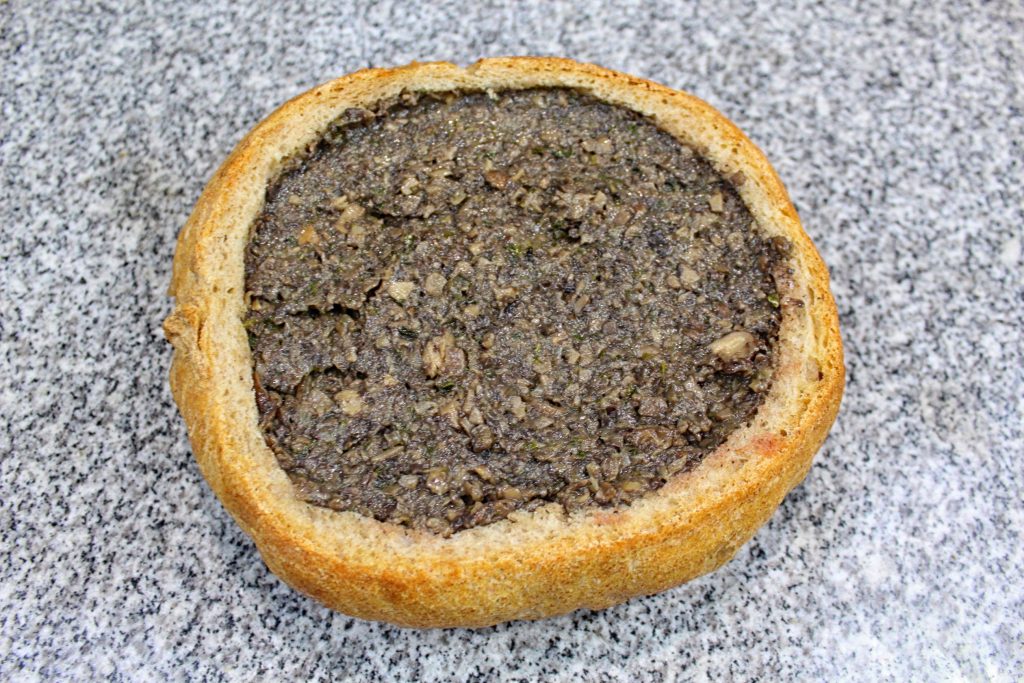
To this, I added another thick layer of beef.
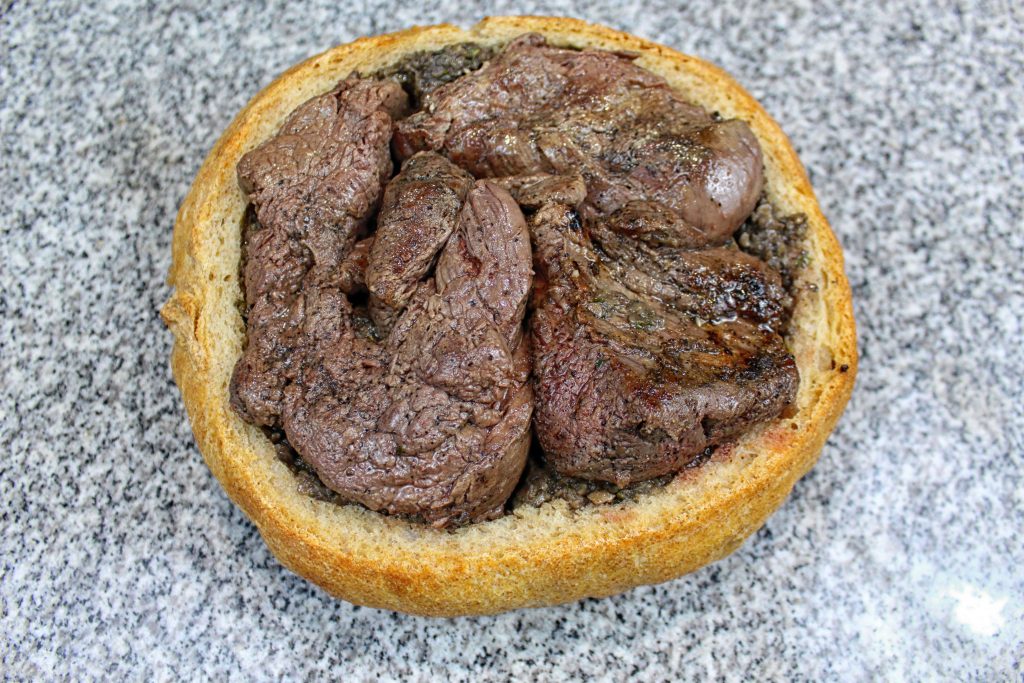
I spread horseradish on top of the beef.
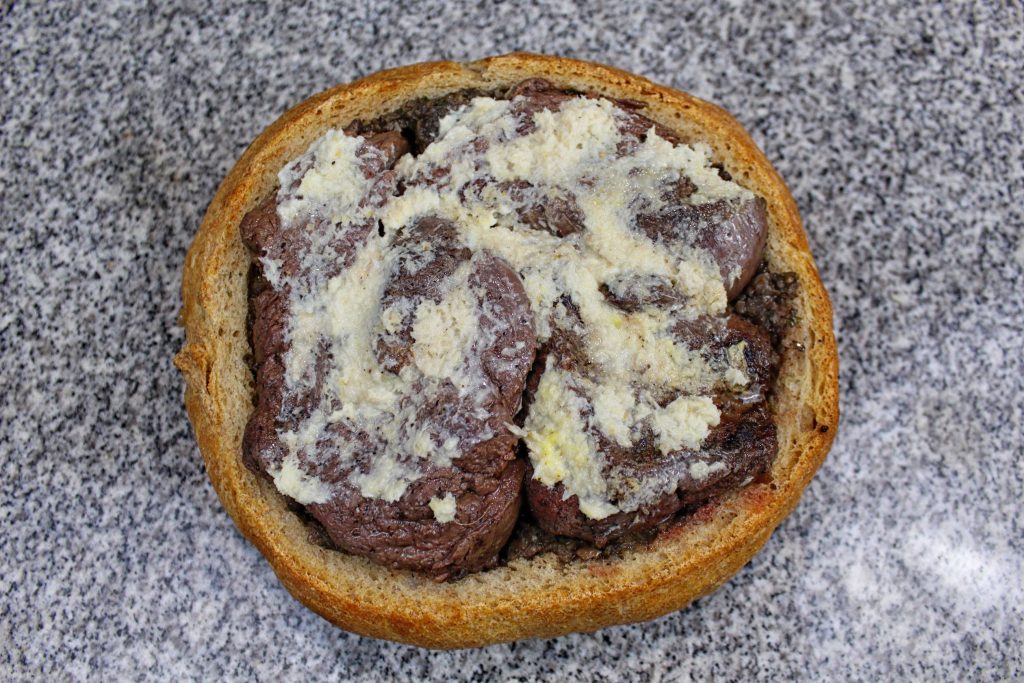
And I added more of the Colman’s English Mustard to the inside of the bread “lid” before replacing it atop the stuffed boule.
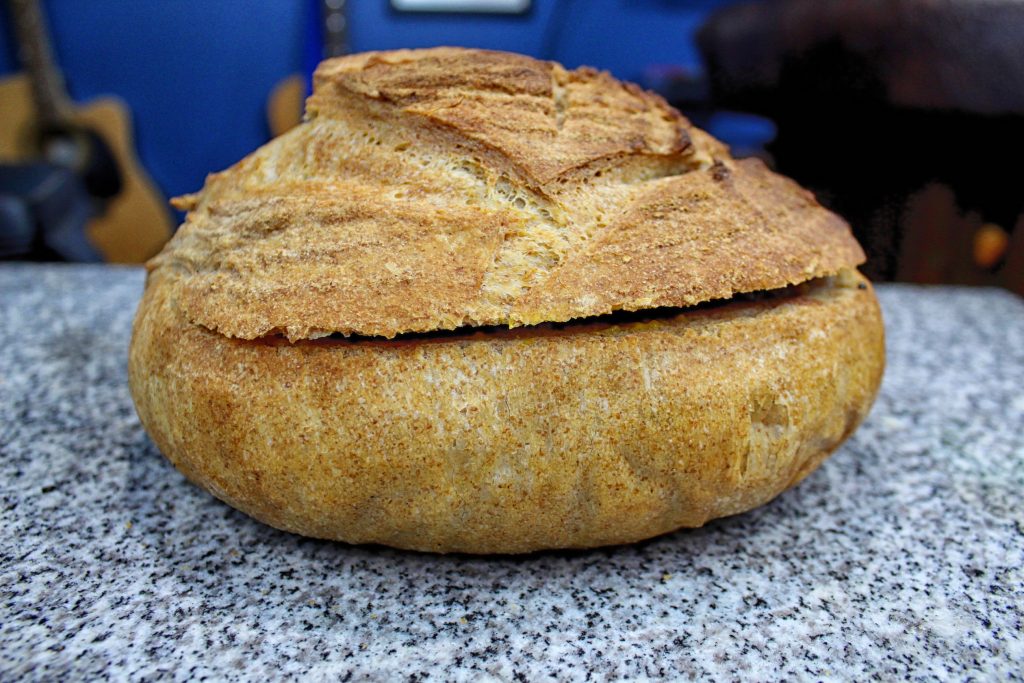
Pressing the Shooter’s Sandwich
It is now time for the final ingredient of the shooter’s sandwich: time’s arrow. Not the somewhat silly two-parter late in Star Trek: the Next Generartion’s run, when we learn that the secret history shared by Guinan and Picard is far more mundane than we imagined, Data finally gets to put his hard-won poker skills to use, and we meet Samuel Clemens. No, I’m talking about the directionality of time and its irreversible effects; I’m talking about entropy and decay; and I’m talking about smashing things with heavier things.
With most sandwiches, it’s best to eat them as quickly after they’re prepared as possible. Really, you’re better off not stopping to take as many pictures of them as I do. For example, a grilled cheese sandwich is best hot and crisp off the griddle, with maybe just enough of a pause that you don’t burn your fingers picking it up. A club sandwich is best when it’s assembled and brought to table quickly enough that the toast is still warm. The “best by” graph of most sandwiches, with time on the X axis and quality of experience on the Y axis, is going to resemble a sledding hill 9 times out of 10.
Not so with the shooter’s sandwich. You may be tempted to dig right in but this thing is not ready yet. The necessary next step in the life cycle of the shooter’s sandwich is to build it a little cocoon, like that of a caterpillar about to undergo its miraculous transformation. However, instead of growing wings, this sandwich is going to be mercilessly crushed under 30 pounds of kitchen gear overnight.
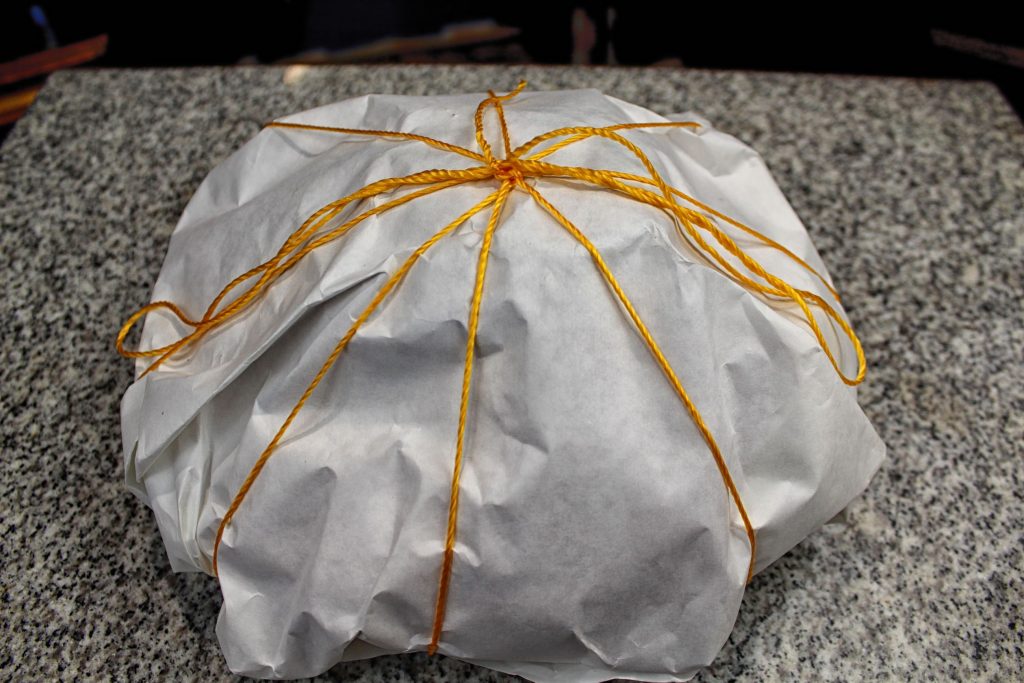
I’m not sure if this step was historically part of making the sandwich, or if it was added on after the fact to simulate the sandwich being crammed into a sack with a bunch of other gear and hauled into the bush on a shooting expedition. Either way, we start by wrapping the sandwich in butcher’s paper and tying it up with twine. Some folks go on from there to wrap it in plastic, or aluminum foil, or wax paper. I think the butcher’s paper is probably enough unless your fridge is really stinky.
I kicked off the pressing of the sandwich by using a 9×13″ pan, with 4 tupperware bowls at the corners to keep it level, and several cast iron pans on top to weight it down.
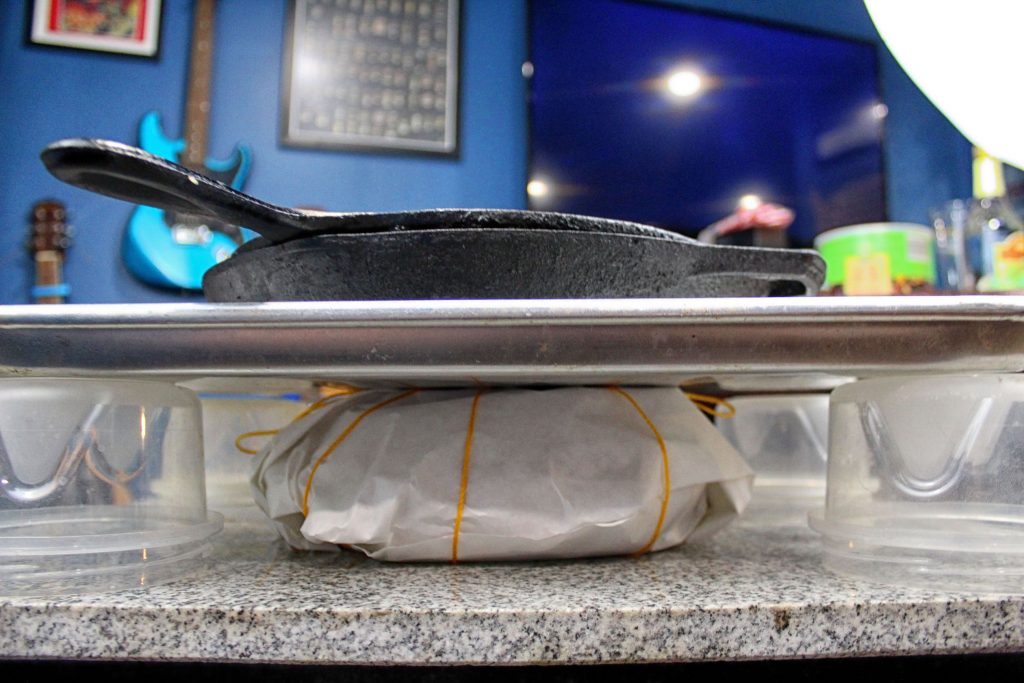
I left it here, at room temperature, for a couple of hours, long enough to create a flat enough surface on the top of the boule to no longer need the tupperware to keep the pans level. Then I moved the sandwich and the pans out to the garage, where they were maintained at a refrigerator-like temperature overnight. (Who can fit all this in their actual fridge?)
After 12-14 hours of being pressed, here is how the package looked.
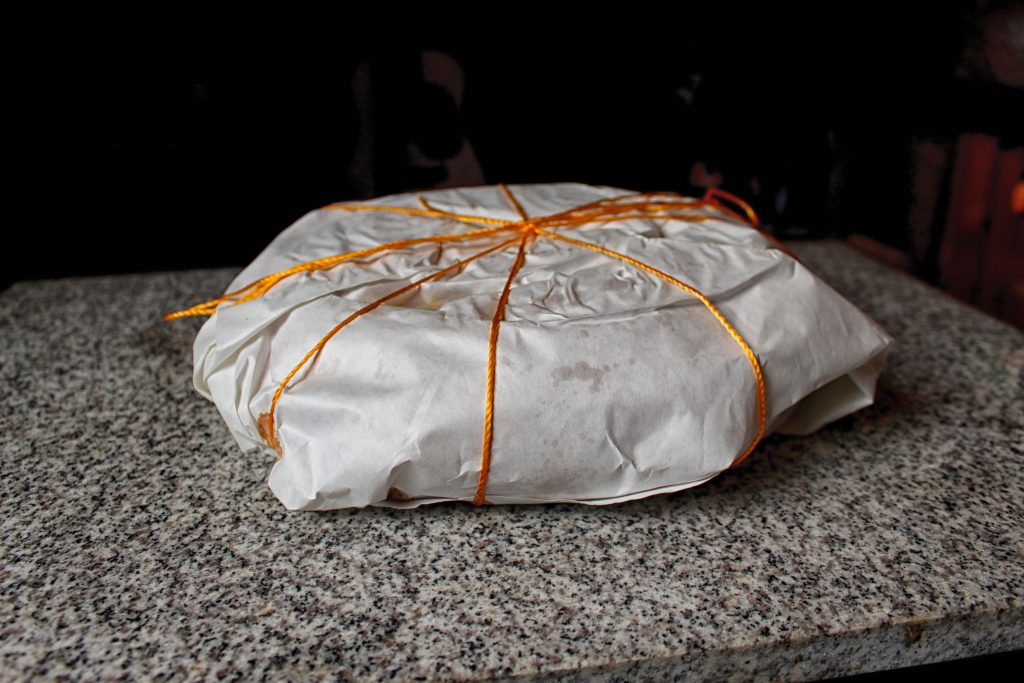
That, my friends, is a flat sandwich.
Eating the Shooter’s Sandwich
We’ve cooked the ingredients, assembled the sandwich, smushed and aged it properly–finally, it is time to eat the thing. With a very large, very sharp knife, cut right through the butcher’s paper, dividing the sandwich in half before further cutting it into wedges.
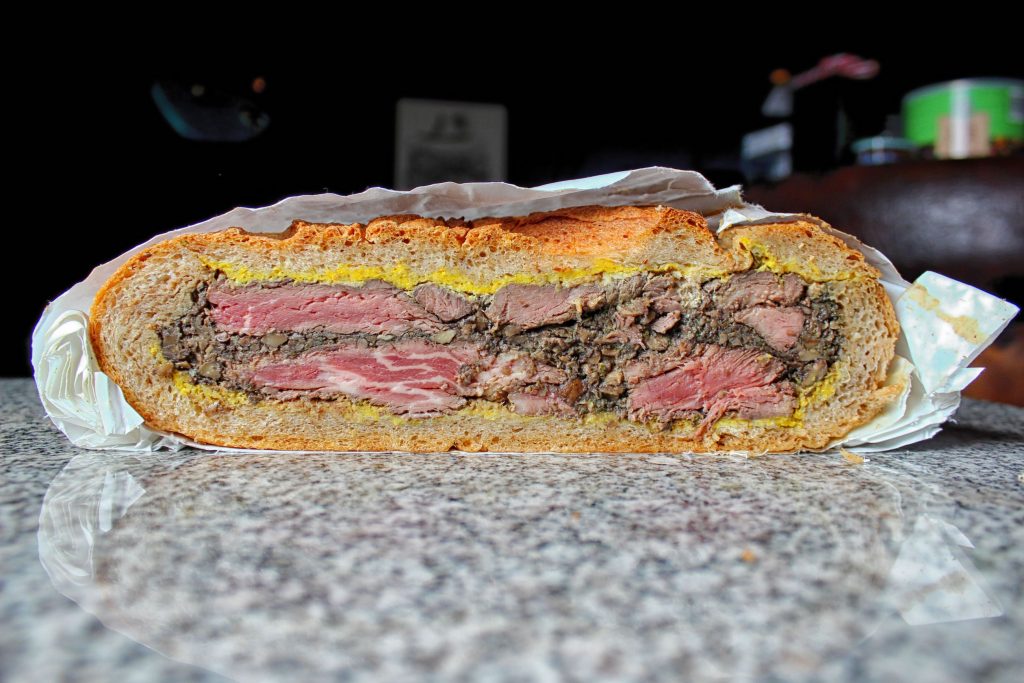
The overnight pressing of the sandwich has deformed it, pushing the two layers of steak closer together and forcing the mushroom duxelles to squeeze itself into whatever spaces are available. The mustard, horseradish, duxelles, and juices from the steak have all begun to soak into the remaining crumb of the bread.
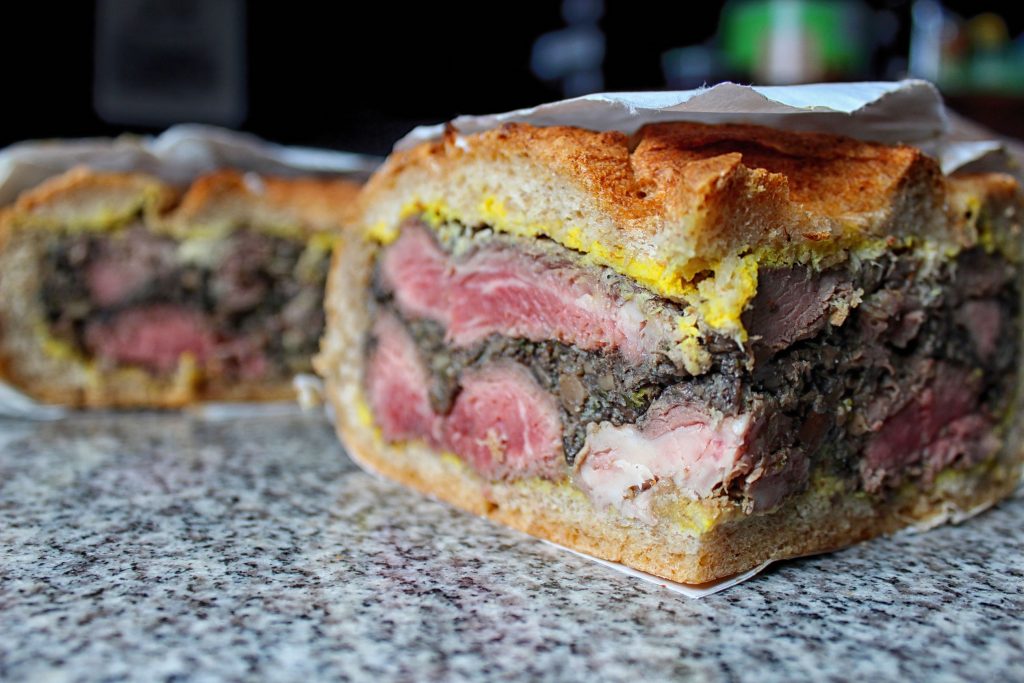
One eighth of this sandwich is about right for a meal-sized portion.
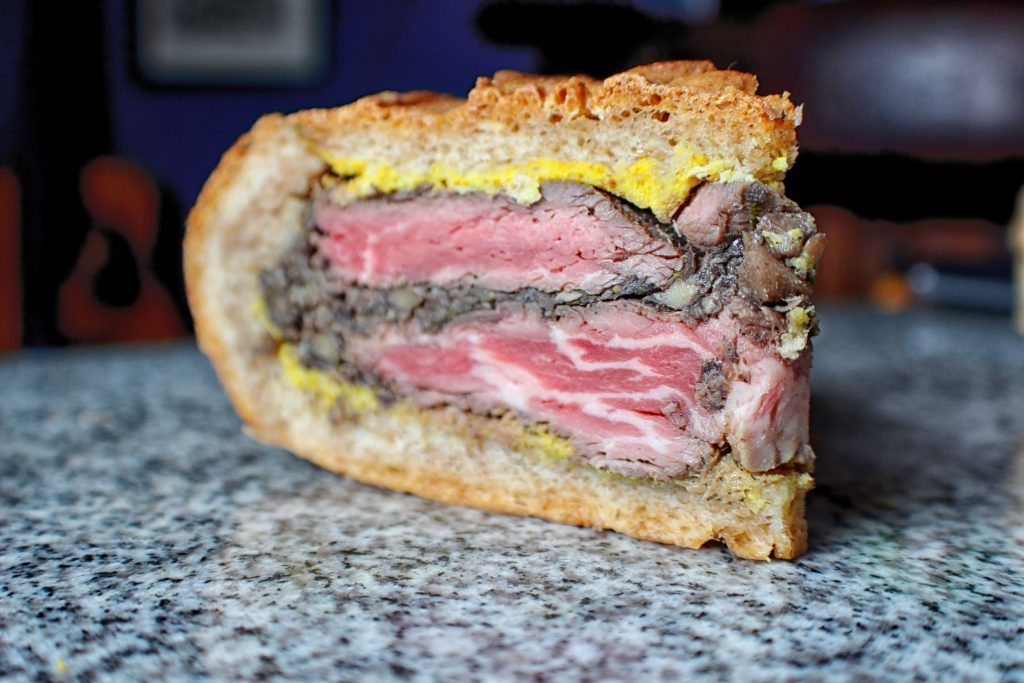
As for the experience–the sandwich is a bit tricky to eat, but it helps to leave the paper on it to help keep it contained. The bread is sturdy enough to take on the juices that it has and not fall apart, the strong brown crust maintaining its shape. The primary flavor is rare lean beef, like a roast, but the softness of the tenderloin makes it easy enough to bite through. The mushroom duxelles is also a major player, the earthy mushroom flavor carrying with it a slight sweetness from the wine and the aromatic qualities of the thyme. The spicy Colman’s mustard and the horseradish also make their presence known, the sinus-clearing pungency darting in at the edges.
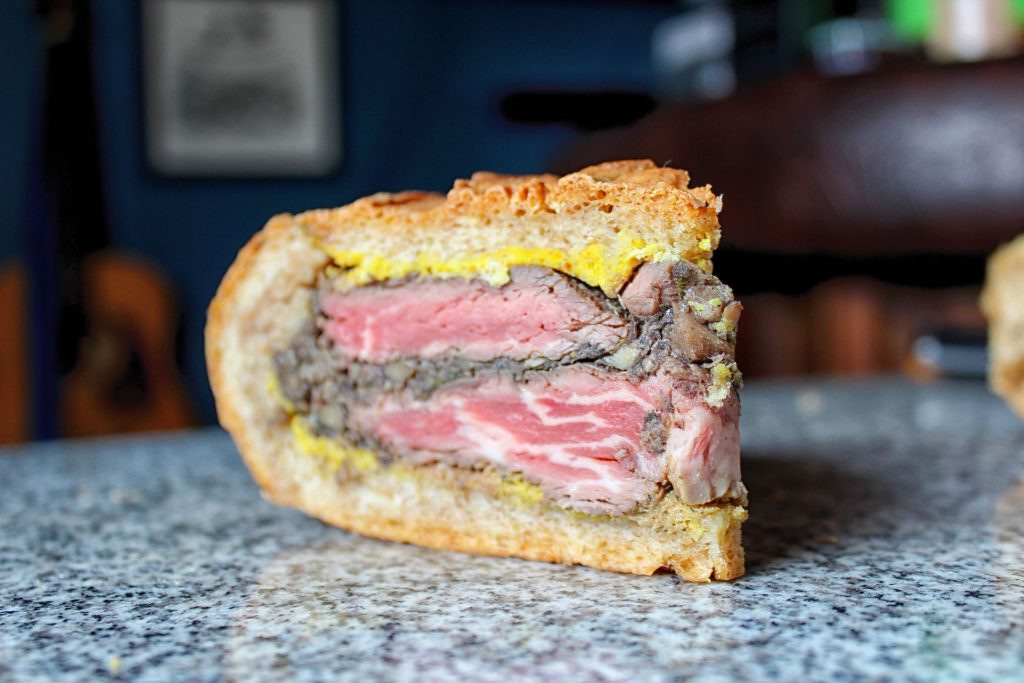
Now I’m not going to tell you eating this sandwich was some kind of transcendent experience. It was not. It was good, solidly good, maybe even great; everything in it was excellent quality, and they all worked well together, and the overnight pressing did allow the whole to come together in a way that improved it. It was greater than the sum of its parts in a way that the great sandwiches are, and while it was a lot of work to put together, it was fun to do it.
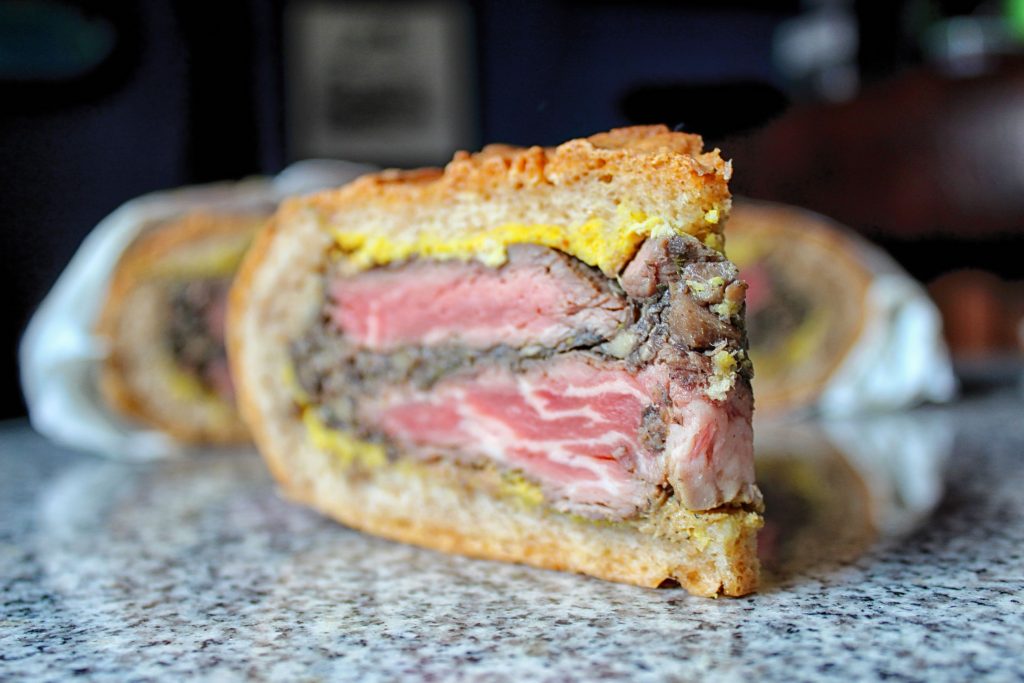
I just don’t know that I ever need to do it again. It’s excessive in a way that I need to avoid these days. One of our tag lines is “Anything worth doing is worth overdoing” but at nearly 50 years old, it may be time for me to rethink the way I’ve been overdoing things. My doctor certainly thinks so.
On the other hand, this is not intended to be an everyday sandwich. The shooter’s sandwich has a very specific function. Perhaps one day, if I’m ever invited out shooting by a bunch of the uppercrust in England, I will revisit it.

I like sandwiches.
I like a lot of other things too but sandwiches are pretty great


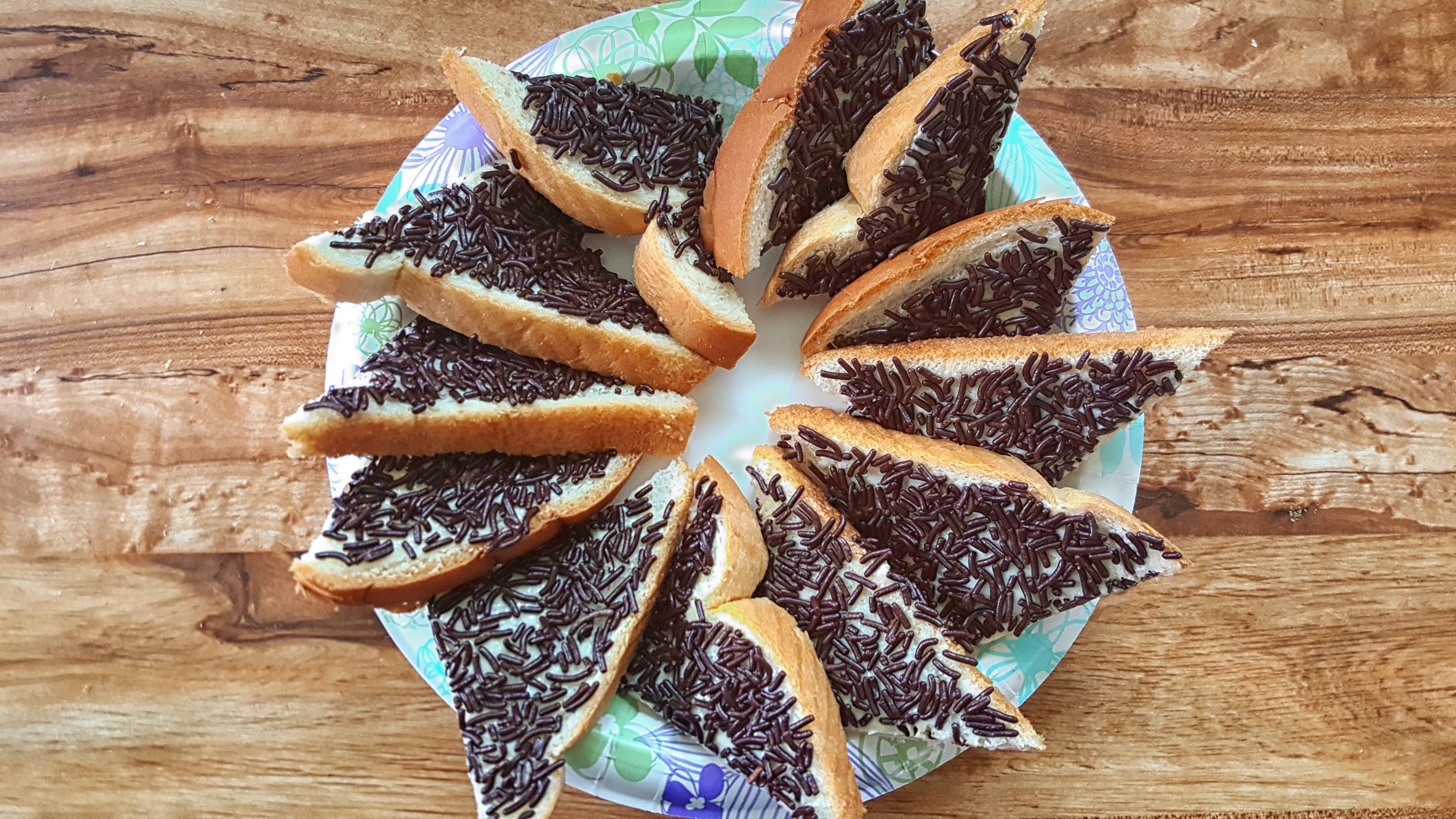


Curious, have you ever tried making a (Italian) picnic loaf?